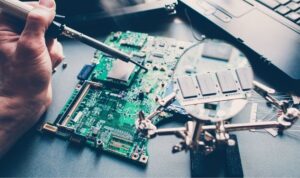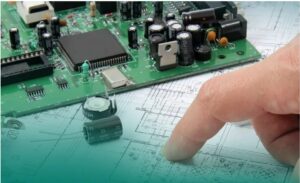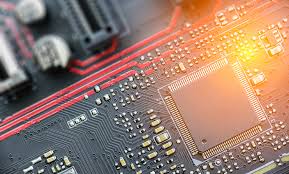01, What is the 20H principle?
The 20H principle refers to the 20H distance of the power layer relative to the ground layer inward, with H indicating the distance between the power layer and the ground layer. And of course to suppress the edge radiation effect. At the edge of the board will radiate electromagnetic interference to the outside. The inward shrinkage of the power supply layer allows the electric field to be conducted only within the range of the grounding layer, effectively improving EMC. if the inward shrinkage is 20H then 70% of the electric field can be confined within the ground edge; the inward shrinkage is 100H then 98% of the electric field can be confined within.
We require the ground plane to be larger than the power or signal layer, which helps prevent external radiation interference and shield the outside world from itself. Generally speaking, the power layer is 1mm inward than the ground layer during PCB design to basically meet the 20H principle.

02, How do the 3W’s and 20H’s reflect in PCB design?
First, the 3W principle, which is easily reflected in the PCB design, ensures that the center of the alignment and alignment spacing is 3 times the line width. For example, the line width of the alignment is 6 mil, so in order to meet the 3W principle, just set the line-to-line rule to 12 mil in Allegro, and the spacing in the software is calculated edge-to-edge.
Second, the 20H principle, in order to reflect the 20H principle during PCB design, we usually just inline the power layer by 1mm compared to the ground layer when dividing the planar layer. Then the shield ground overholes are punched in the 1mm indented band, 150mil one.
03, How many types of signal lines are there in a PCB and what are the differences?
There are two types of signal lines in a PCB, a microstrip line and a ribbon line.
The microstrip line, which is walking on the surface layer (microstrip), is attached to the surface of the PCB strip alignment, as shown in Figure 1, the blue part is the conductor, the green part is the insulation dielectric of the PCB, and the small blue piece on top is the microstrip line (microstrip line). As the microstrip line (microstrip line) is exposed in the air on one side, can be formed to the surrounding radiation or interference by the surrounding radiation, while the other side is attached to the PCB insulation dielectric, so it forms part of the electric field distribution in the air, the other part of the distribution in the PCB insulation dielectric. However, the signal transmission speed in microstrip line is faster than that in stripline (ribbon line), which is its outstanding advantage.
Stripline: the walk on the inside (stripline/double stripline), buried inside the PCB strip alignment, as shown in Figure 2, the blue part is the conductor, the green part is the insulating dielectric of the PCB, and the stripline is the strip wire embedded between the two conductor layers. Because the stripline is embedded between the two layers of conductors, so its electric field distribution are in the two package it between the conductors (plane), will not radiate out energy, and will not be subject to external radiation interference. However, because it is surrounded by a dielectric (dielectric constant greater than 1), the signal is transmitted more slowly in the stripline than in the microstrip line.
04, What is EMC?
EMC stands for Electro Magnetic Compatibility, which translates to electromagnetic compatibility, and refers to the ability of a device or system to function properly in its electromagnetic environment and not pose an unbearable electromagnetic nuisance to anything in that environment. Sensor electromagnetic compatibility refers to the sensor’s ability to adapt in the electromagnetic environment, maintain its inherent performance, and complete the required functions.
It consists of two requirements: on the one hand, the sensor must not exceed a certain limit of electromagnetic interference to its environment during normal operation; on the other hand, the sensor must have a certain degree of immunity to the presence of electromagnetic interference in its environment.
05, Design method to distinguish between analog and digital ground in PCB design?
There are several general ways to handle analog ground and digital ground:
Directly separate, connect the ground in the digital area as DGND and the ground in the analog area as AGND in the schematic, then split the ground plane in the PCB into digital and analog ground and space them out;
Connect the digital ground to the analog ground with a magnetic bead;
Digital ground is connected to analog ground with a capacitor, using the principle of capacitive isolation through crossover;
Digital ground is connected to analog ground with an inductor, with inductance values ranging from uH to tens of uH;
The digital ground is connected to the analog ground with a zero-ohm resistor.
To summarize, capacitor isolation through DC causes a floating ground. The capacitor does not pass DC, which will lead to voltage difference and static build-up, and will numb your hands when you touch the case. If you connect the capacitor and the bead in parallel, you are adding to the problem, because the bead is straight and the capacitor will fail. If you connect them in series, it looks uncomfortable.
The inductor is large, has many spurious parameters, unstable characteristics, poorly controlled discrete distribution parameters, and large size. The inductor is also trapped, LC resonant (distributed capacitance), and has special effects on noise.
The equivalent circuit of magnetic beads is equivalent to a bandstop trap, which only suppresses noise at a certain frequency point. If you can’t predict the noise point, how to choose the model, and besides, the noise frequency is not necessarily fixed, so magnetic beads are not a good choice.
Zero-ohm resistors are equivalent to very narrow current paths, effectively limiting loop currents and enabling noise suppression. The resistor has an attenuating effect in all frequency bands (zero-ohm resistors also have impedance), which is stronger than magnetic beads.
In summary, the key is to ground the analog and digital grounds at one point. It is recommended that different kinds of grounds be connected with zero-ohm resistors; that magnetic beads be used when power is introduced into high-frequency devices; that small capacitors be used for high-frequency signal line coupling; and that inductors be used for high-power low frequencies.















